LaksaMana, Bedok Corner: “An academic study in all things Laksa”
Encyclopedias in a hawker centre? Quite the wild concept indeed. Until I’ve set foot in Bedok Corner, that is. For starters, there’s food at every turn. Having the stores laid out in circular fashion leaves me a little disoriented with choices, but that’s a happy problem. I’ll skip the formalities of ayam penyet and sticks of mutton satay because today, Muslim-owned LaksaMana catches my eye and appetite.
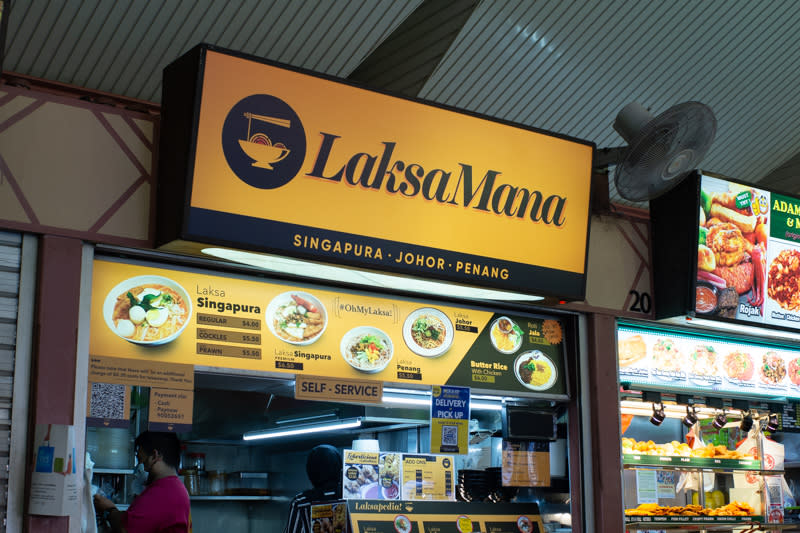
I inch closer to its bright orange storefront. There are paragraphs of text to be read here which usually repel me in school, but for this ubiquitous noodle dish, I’ll bite. It’s all nestled under a fun ‘Laksapedia!’ that introduces a trifecta of laksa types, split geographically. Can’t a boy just ask for some noodles without all this fuss? Well, it’s back to school for this writer, because some proper culinary education is due.
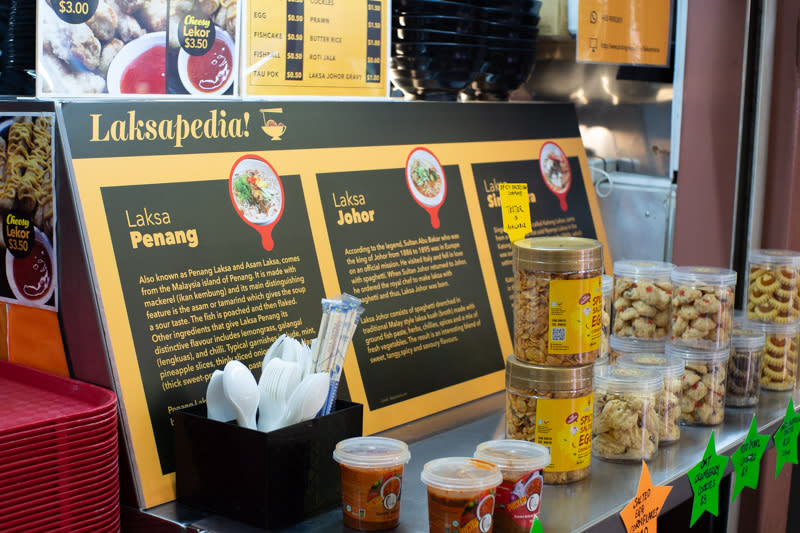
If the punchy infographics and chirpy #ohmylaksa hashtags don’t quell your wanderlust, I don’t know what will. To provide some background information, LaksaMana translates to ‘Laksa where?’, which makes for a keen prompt to the stall’s aptly named offerings. We’re talking about regional variations of laksa here, namely between Singapore, Penang, and Johor. If there ever was a degree in laksa types, this would be the institution to get ahold of one.
What I tried
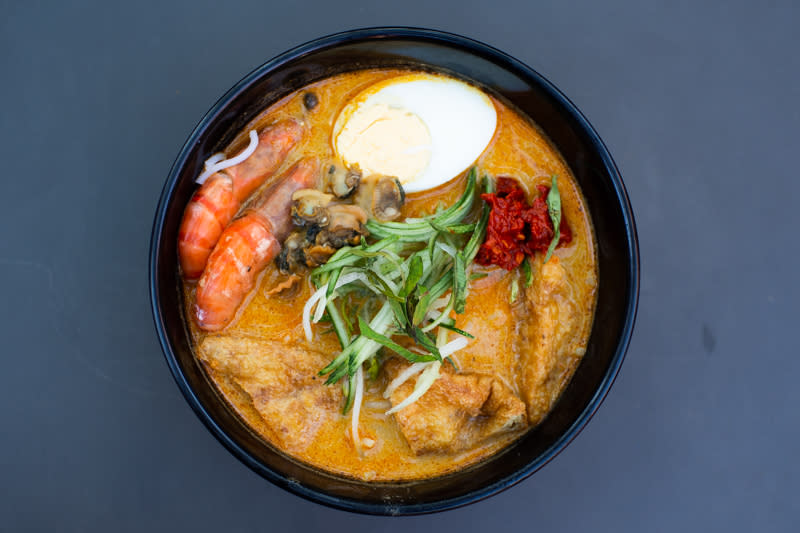
I’ll jump right in with the patriotic—and perhaps most familiar—Laksa Singapura (S$6.50). Otherwise known as Katong Laksa, this is a local variant of the spicy noodle dish which is unique to our little red dot. Here, the kitchen serves up a version that checks all the right ingredient boxes.
You get splashes of coconut milk, a dollop of sambal, and a heap of cockles in the broth. LaksaMana’s variant is on the lighter side of things. There’s a subtle, pleasant fragrance of santan (coconut milk) that permeates each bite. It’s as if it cares little for the inevitable comparison to the Katong, Roxy, or Janggut iteration; more commonly known by the general populace. Nonetheless, I feel that a more intensely seasoned laksa broth would benefit this bowl. Perhaps the more health-conscious of diners would appreciate this restraint in flavour. Still, we enjoy slurping up the thick rice vermicelli noodles and sipping on the lightly spicy gravy.
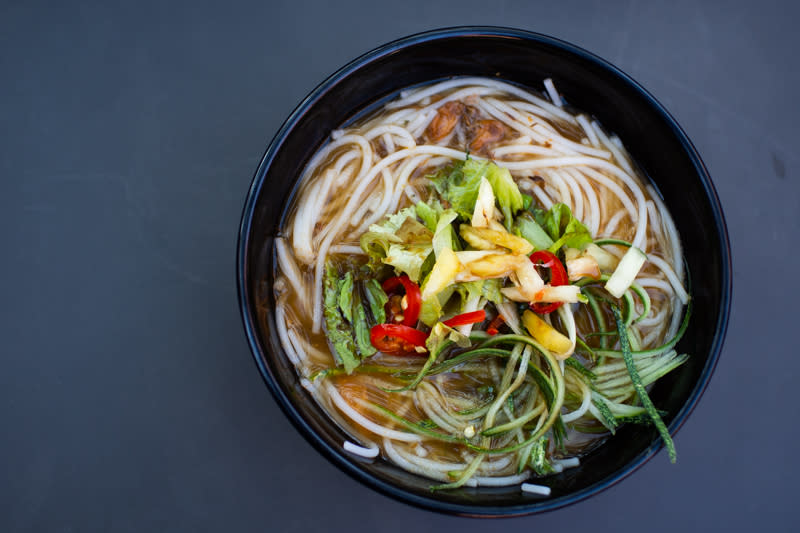
Next up on the timetable is the Laksa Penang (S$5.50) lesson. If you have yet to be acquainted with this variant, here’s my best attempt at summarising some of its key characteristics. Straying further away from the indulgent, coconut-packed side of things, this style of laksa broth is heavily empowered by asam (tamarind) and ikan kembung (mackerel). The execution here is no different, boasting a bright, sour taste that gently coaxes the palate. This too tastes like something straight out of a home kitchen where lingering second and third helpings call for something less heavy in flavour.
Once again, my dining partner and I concur that this bowl of noodles is markedly lighter in flavour. And that’s a good thing, at least in my opinion. We enjoy the enticing citrusy components of sliced pineapple and fresh cucumber. Within the broth lies chunks of mackerel, which are a neat savoury touch to the dish. For two dishes that share the same moniker, this Laksa Penang presents a stark contrast to the creamy notes of the Laksa Singapura before.
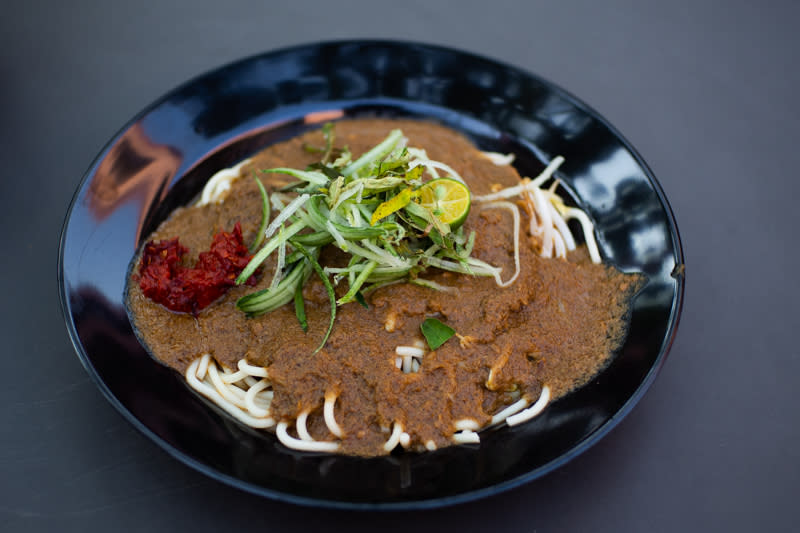
As for the third and final instalment in today’s enriching laksa module, we find ourselves face-to-face with the Laksa Johor (S$5.50). To be perfectly candid, we found ourselves wholly unacquainted with this dish. But in the spirit of lifelong learning, some spirited conversation with the hawkers of LaksaMana and a few Google searches bequeathed us with some much-needed knowledge. Of course, tasting it sits first on the agenda.
Digging into this plate, I’m thrown off by the choice of noodles—it’s spaghetti. I’d expect to see this from the western stall down the row, not here. Then there’s a mysterious coating of dark gravy that sits atop the noodles. This one’s heavily shrouded in mystery and our taste buds are only further intrigued by its lightly savoury and nutty notes.
There is a rounded umami to the dish which I can’t quite wrap my head around, until the stall owner tells us that this Laksa Johor gravy is made with mackerel paste. So that’s what I’ve been detecting. In addition, a flurry of herbs, spices, and chillies are thrown into the mix to create an interesting blend of flavours. This dish’s supposed origin was attributed to Sultan Abu Bakar, who fell in love with spaghetti during a trip to Italy. He then demanded his royal chefs in Johor to create a dish with the same noodles. And thus, Laksa Johor was born. Needless to say, this menu item that was once foreign now seems all the more relatable.
Final thoughts

Three servings of laksa down, and we’re stuffed to the brim. But we leave with our minds particularly invigorated, and eyes opened to the vibrant world of laksa noodles. Did I get out of bed this morning knowing that I’d be educating myself about this? Nope. Then again, the best learning opportunities are often unexpected.
I urge those of you curious foodies to grab a friend and come down to Bedok Corner to give LaksaMana a go. After all, what could hurt with indulging in some communal laksa slurping?
Expected damage: S$4 – S$6.50 per pax
Other articles you might like:
Fatty Fong, Bedok: “It’s brilliant dependable cooking.”
Phat Burger Bro, River Valley: “Order a double and get your hands dirty.”
The post LaksaMana, Bedok Corner: “An academic study in all things Laksa” appeared first on SETHLUI.com.


